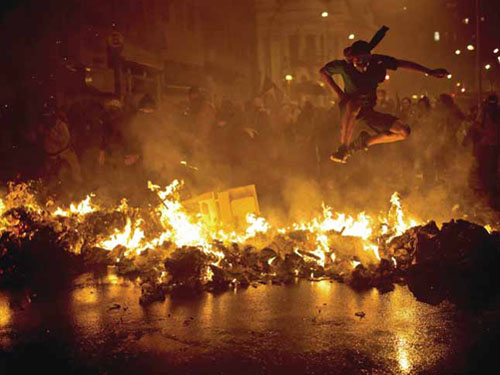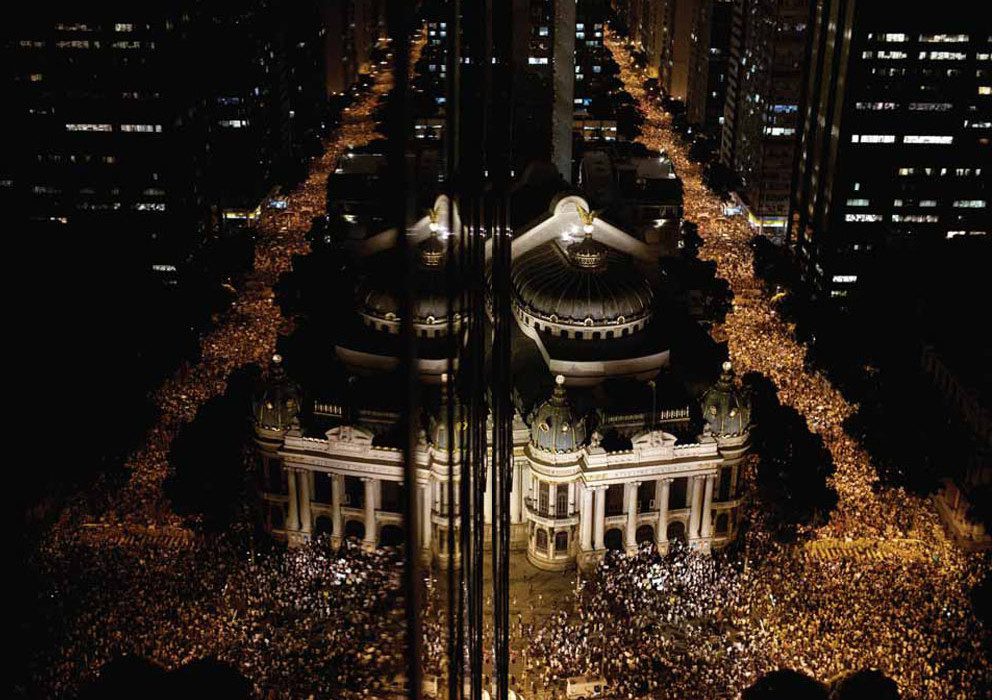The night of 30th June, 2013 shall go down memory as one of intense drama in Rio De Janeiro. The red carpet had been rolled out. The photographers primed. Inside the refurbished Maracanã Stadium, thousands of Brazilians erupted as Neymar scored the second of their three goals which ensured their 3-0 win over World Champions Spain, in the Confederations Cup final. And then came the tear gas. As thousands erupted with joy inside Maracanã, millions outside lit up Rio in flames of protest, as they faced off with the police in riot gear, the air thick with insults. When Thiago Silva lifted the trophy to send alarming signals across the footballing world, little did they know that the next day’s front pages would be rather dedicated to the might and display of their countrymen outside.
Three and half months later, on 15th October, 2013, when teams such as current champion Spain, England and Chile won games they needed to qualify for the 32-team tournament next summer, a few miles from Maracanã, the air was thick again. This time around, the protests had shifted to a theater in downtown Rio, as it disrupted the premiere of City of God: 10 Years Later; a follow-up take on the much appreciated City of God. 10,000 odd people joined in support of dozens of striking teachers, as they clashed against the riot police, once more. As teachers began to head home, hundreds of black-clad youths, known as the “Black Bloc” after the anarchist demonstration tactics they adhere to, began battling the outnumbered police. Violence was sparked. Hundreds were detained, including quite a few innocent ones. “Police don’t know who is being good and who is being bad and start going willy-nilly with deployment of gas, flash-bang devices, pepper weapons, and then everyone becomes a victim,” said Eduardo Jany, a security consultant who has worked with forces across Brazil, in an interview with The Guardian.

That was the second teachers’ demonstration in a week to end in violence. As in June, when hundreds of thousands took to the streets, crying for better health, transport and education services and an end to corruption, among other things, one rallying cry was: “THERE WON’T BE ANY WORLD CUP.” Reading news reports the next day, football fans planning their 2014 trips to the land of Samba must have wondered: whatever happened to the carnival?
The protests against the hosting of the mega event in Brazil only showcases FIFA’s tryst with troubled World Cups. Every world cup has had its unique issues: With Germany 2006, it was the issue of rival European fans. With South Africa 2010, FIFA faced the question of whether the country’s security forces were up for the job. And now with Brazil, the money-mongering FIFA’s primary concern seems to be able to woo the tourism industries.
Official reports suggest that Brazil is spending about 30 billion reais to host the World Cup. And FIFA claims that the hosts will earn about 112 billion reais from the mega event. So just how much cash does FIFA expect to pocket? In 2010, it took home truly impressive revenue of $3.2 billion with event-related costs of $1.2 billion, which led to a “surplus” (please don’t call it a profit) of a whooping $2 billion for the 2010 World Cup.

And how much revenue did South Africa earn from hosting the World Cup? FIFA made a contribution of around $500 million to the Local Organising Committee and the South Africans retained the net income from ticket sales (the only risky revenue stream), but this was small change compared to the money needed to fund new stadiums, improved transport networks and better security. This financial imbalance famously gave the expression “a game of two halves” a whole new meaning in Johannesburg, in 2010.
Brazil’s bid for the Cup proposed spending less than $1 billion on stadiums, but updated projections say the costs will exceed $3 billion in public funds. And most of the transportation and infrastructure projects that were supposed to benefit all Brazilians have been canceled or delayed.
As the government invests massive amounts of money for stadiums, Brazilians are now wondering why politicians were asking them to pay more to ride the bus, why their overcrowded hospitals and crumbling schools aren’t built to “FIFA standards” in the first place, and why the prosperity they were promised seems like such a pipe-dream now.
“If you view it as a business where the object is to be profitable, then the answer is no [they aren’t cost-efficient],” University of Michigan sports economist Stefan Szymanski said. “We should all know that from the beginning. That’s the whole reason governments are involved in this. There would be no government involvement in this if these things were privately profitable. So what they require is a massive government subsidy — a growing government subsidy.”
Even if Brazil settles down before the World Cup begins next year, the protests have already forced economic policy alterations, and they may ultimately make the rest of the world and FIFA acknowledge the fact that the formula of ‘prosperity and success’ they’re selling doesn’t work. The World Cup isn’t a major economic revitalization project. Acknowledging that reality and promoting the World Cup for what it is – significantly social and cultural – may make them harder to justify, but it could also lead to a better sporting event that isn’t packaged with a wrapper of prosperity. Taking that path will be tough for FIFA, because less costly stadiums and less lofty goals play against their interests.
Sports has always been considered the drug of the people. Well, the people in Brazil are now climbing the walls of Rio’s municipal chamber, and spray-painting “Get Out FIFA”.














